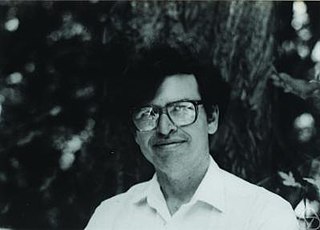In the mathematical field of geometric topology, the Poincaré conjecture is a theorem about the characterization of the 3-sphere, which is the hypersphere that bounds the unit ball in four-dimensional space.

William Paul Thurston was an American mathematician. He was a pioneer in the field of low-dimensional topology and was awarded the Fields Medal in 1982 for his contributions to the study of 3-manifolds.
In mathematics, Thurston's geometrization conjecture states that each of certain three-dimensional topological spaces has a unique geometric structure that can be associated with it. It is an analogue of the uniformization theorem for two-dimensional surfaces, which states that every simply connected Riemann surface can be given one of three geometries . In three dimensions, it is not always possible to assign a single geometry to a whole topological space. Instead, the geometrization conjecture states that every closed 3-manifold can be decomposed in a canonical way into pieces that each have one of eight types of geometric structure. The conjecture was proposed by William Thurston, and implies several other conjectures, such as the Poincaré conjecture and Thurston's elliptization conjecture.

In mathematics, low-dimensional topology is the branch of topology that studies manifolds, or more generally topological spaces, of four or fewer dimensions. Representative topics are the structure theory of 3-manifolds and 4-manifolds, knot theory, and braid groups. This can be regarded as a part of geometric topology. It may also be used to refer to the study of topological spaces of dimension 1, though this is more typically considered part of continuum theory.

Geometric group theory is an area in mathematics devoted to the study of finitely generated groups via exploring the connections between algebraic properties of such groups and topological and geometric properties of spaces on which these groups act.

In mathematics, a 3-manifold is a topological space that locally looks like a three-dimensional Euclidean space. A 3-manifold can be thought of as a possible shape of the universe. Just as a sphere looks like a plane to a small and close enough observer, all 3-manifolds look like our universe does to a small enough observer. This is made more precise in the definition below.
In mathematics, more precisely in topology and differential geometry, a hyperbolic 3-manifold is a manifold of dimension 3 equipped with a hyperbolic metric, that is a Riemannian metric which has all its sectional curvatures equal to −1. It is generally required that this metric be also complete: in this case the manifold can be realised as a quotient of the 3-dimensional hyperbolic space by a discrete group of isometries.
In the mathematical subfield of 3-manifolds, the virtually fibered conjecture, formulated by American mathematician William Thurston, states that every closed, irreducible, atoroidal 3-manifold with infinite fundamental group has a finite cover which is a surface bundle over the circle.
In topology, an area of mathematics, the virtually Haken conjecture states that every compact, orientable, irreducible three-dimensional manifold with infinite fundamental group is virtually Haken. That is, it has a finite cover that is a Haken manifold.
The Oswald Veblen Prize in Geometry is an award granted by the American Mathematical Society for notable research in geometry or topology. It was funded in 1961 in memory of Oswald Veblen and first issued in 1964. The Veblen Prize is now worth US$5000, and is awarded every three years.
Brian Hayward Bowditch is a British mathematician known for his contributions to geometry and topology, particularly in the areas of geometric group theory and low-dimensional topology. He is also known for solving the angel problem. Bowditch holds a chaired Professor appointment in Mathematics at the University of Warwick.
In mathematics, more precisely in group theory and hyperbolic geometry, Arithmetic Kleinian groups are a special class of Kleinian groups constructed using orders in quaternion algebras. They are particular instances of arithmetic groups. An arithmetic hyperbolic three-manifold is the quotient of hyperbolic space by an arithmetic Kleinian group.

John Robert Stallings Jr. was a mathematician known for his seminal contributions to geometric group theory and 3-manifold topology. Stallings was a Professor Emeritus in the Department of Mathematics at the University of California at Berkeley where he had been a faculty member since 1967. He published over 50 papers, predominantly in the areas of geometric group theory and the topology of 3-manifolds. Stallings' most important contributions include a proof, in a 1960 paper, of the Poincaré Conjecture in dimensions greater than six and a proof, in a 1971 paper, of the Stallings theorem about ends of groups.
James W. Cannon is an American mathematician working in the areas of low-dimensional topology and geometric group theory. He was an Orson Pratt Professor of Mathematics at Brigham Young University.
In geometric group theory, the Rips machine is a method of studying the action of groups on R-trees. It was introduced in unpublished work of Eliyahu Rips in about 1991.

Ian Agol is an American mathematician who deals primarily with the topology of three-dimensional manifolds.

Mahan Maharaj, also known as Mahan Mj and Swami Vidyanathananda, is an Indian mathematician and monk of the Ramakrishna Order. He is currently Professor of Mathematics at the Tata Institute of Fundamental Research in Mumbai. He is a recipient of the 2011 Shanti Swarup Bhatnagar Award in mathematical sciences and the Infosys Prize 2015 for Mathematical Sciences. He is best known for his work in hyperbolic geometry, geometric group theory, low-dimensional topology and complex geometry.
In mathematics, the curve complex is a simplicial complex C(S) associated to a finite-type surface S, which encodes the combinatorics of simple closed curves on S. The curve complex turned out to be a fundamental tool in the study of the geometry of the Teichmüller space, of mapping class groups and of Kleinian groups. It was introduced by W.J.Harvey in 1978.
Albert Marden is an American mathematician, specializing in complex analysis and hyperbolic geometry.

Michael Kapovich is a Russian-American mathematician.









